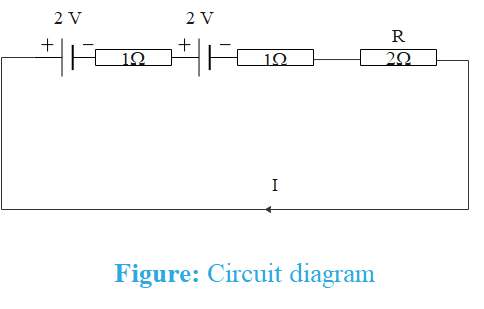
Two cells of each 2V and internal resistance $1\Omega $are connected in series to a resistor $R\,=\,2\Omega $. What is the maximum possible power consumed by the resistor R?
A. $\dfrac{8}{9}\,W$
B. $3.2\,W$
C. $\dfrac{16}{9}\,W$
D. $2\,W$
Answer
486.9k+ views
Hint: Draw the circuit diagram as per the details given in the question. When resistances are connected in series, the current is the same through each resistance and total resistance is the sum of all the resistances connected in series.
To determine power consumed by the resistor, first find current through the resistor and then use formula for power.
Formula used:
Net resistance connected in series, $R={{R}_{1}}+{{R}_{2}}+{{R}_{3}}......$, Net potential difference of cells connected in series,${{V}_{net}}=2\,V+2\,V=4\,V$ and Power, $P={{I}^{2}}R$
Complete step-by-step answer:
Both cells and resistance are connected in series as shown below

Two cells and one resistor are connected in series. In series, the value of current remains the same.
The net resistance in a series circuit is the sum of the individual resistance of each resistor.
Therefore, the net resistance of this circuit is the sum of internal resistances and resistance of R.
${{R}_{net}}=1\Omega +1\Omega +2\Omega =4\Omega $
According to Ohm’s law, the potential through a resistor R is directly proportional to current through it.
$\begin{align}
& V\propto I \\
& \Rightarrow V=IR \\
\end{align}$
Total potential difference in a series circuit is also the sum of the potential difference of each cell connected in series. Therefore,
${{V}_{net}}=2\,V+2\,V=4\,V$
Using Ohm’s law, current through the circuit is
$I=\dfrac{{{V}_{net}}}{{{R}_{net}}}$
$I=\dfrac{4\,V}{4\,\Omega }=1A$
Power in a resistance is given as
$P={{I}^{2}}R$
Therefore, the power consumed by resistance R is
$P={{1}^{2}}\times 2=2\,\,\,Watt$
So, the correct answer is “Option D”.
Note: The power given by each cell is 2 Watt.
When resistances are connected in series, the total resistance is the sum of each resistor’s resistance.
When two or more cells are connected in series, the net potential through the series circuit is the sum of potential difference of each cell.
To determine power consumed by the resistor, first find current through the resistor and then use formula for power.
Formula used:
Net resistance connected in series, $R={{R}_{1}}+{{R}_{2}}+{{R}_{3}}......$, Net potential difference of cells connected in series,${{V}_{net}}=2\,V+2\,V=4\,V$ and Power, $P={{I}^{2}}R$
Complete step-by-step answer:
Both cells and resistance are connected in series as shown below

Two cells and one resistor are connected in series. In series, the value of current remains the same.
The net resistance in a series circuit is the sum of the individual resistance of each resistor.
Therefore, the net resistance of this circuit is the sum of internal resistances and resistance of R.
${{R}_{net}}=1\Omega +1\Omega +2\Omega =4\Omega $
According to Ohm’s law, the potential through a resistor R is directly proportional to current through it.
$\begin{align}
& V\propto I \\
& \Rightarrow V=IR \\
\end{align}$
Total potential difference in a series circuit is also the sum of the potential difference of each cell connected in series. Therefore,
${{V}_{net}}=2\,V+2\,V=4\,V$
Using Ohm’s law, current through the circuit is
$I=\dfrac{{{V}_{net}}}{{{R}_{net}}}$
$I=\dfrac{4\,V}{4\,\Omega }=1A$
Power in a resistance is given as
$P={{I}^{2}}R$
Therefore, the power consumed by resistance R is
$P={{1}^{2}}\times 2=2\,\,\,Watt$
So, the correct answer is “Option D”.
Note: The power given by each cell is 2 Watt.
When resistances are connected in series, the total resistance is the sum of each resistor’s resistance.
When two or more cells are connected in series, the net potential through the series circuit is the sum of potential difference of each cell.
Recently Updated Pages
Master Class 12 Social Science: Engaging Questions & Answers for Success

Class 12 Question and Answer - Your Ultimate Solutions Guide

Class 10 Question and Answer - Your Ultimate Solutions Guide

Master Class 10 Science: Engaging Questions & Answers for Success

Master Class 10 Maths: Engaging Questions & Answers for Success

Master Class 9 General Knowledge: Engaging Questions & Answers for Success

Trending doubts
The gas that burns in oxygen with a green flame is class 12 chemistry CBSE

The probability that a leap year will have only 52 class 12 maths CBSE

Describe the poetic devices used in the poem Aunt Jennifers class 12 english CBSE

And such too is the grandeur of the dooms We have imagined class 12 english CBSE

What does the god that failed refer to class 12 english CBSE

Which country did Danny Casey play for class 12 english CBSE




